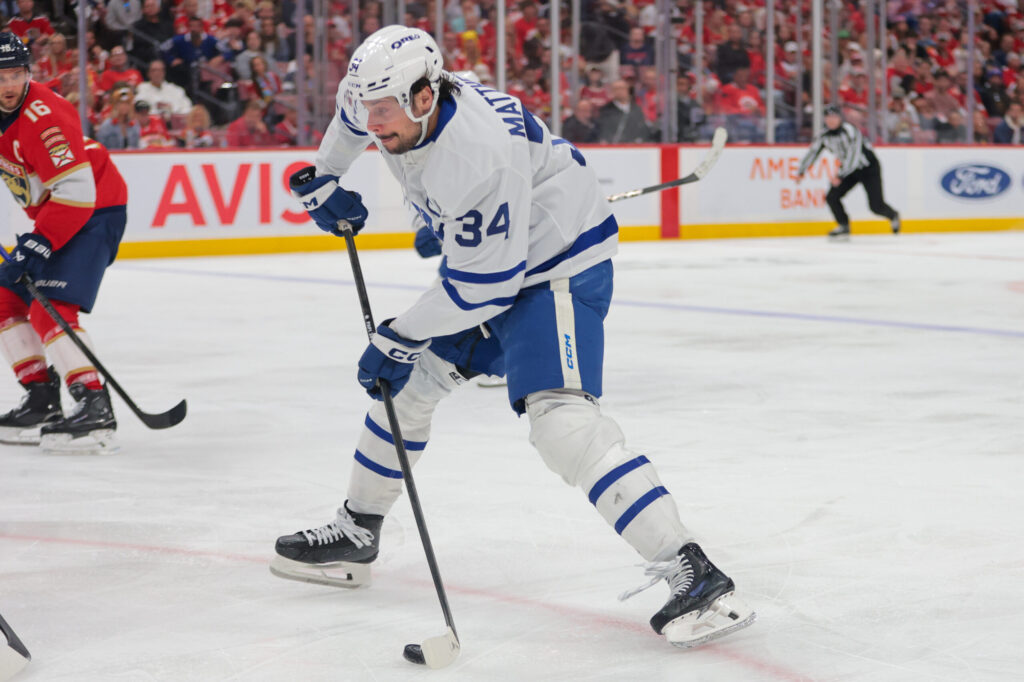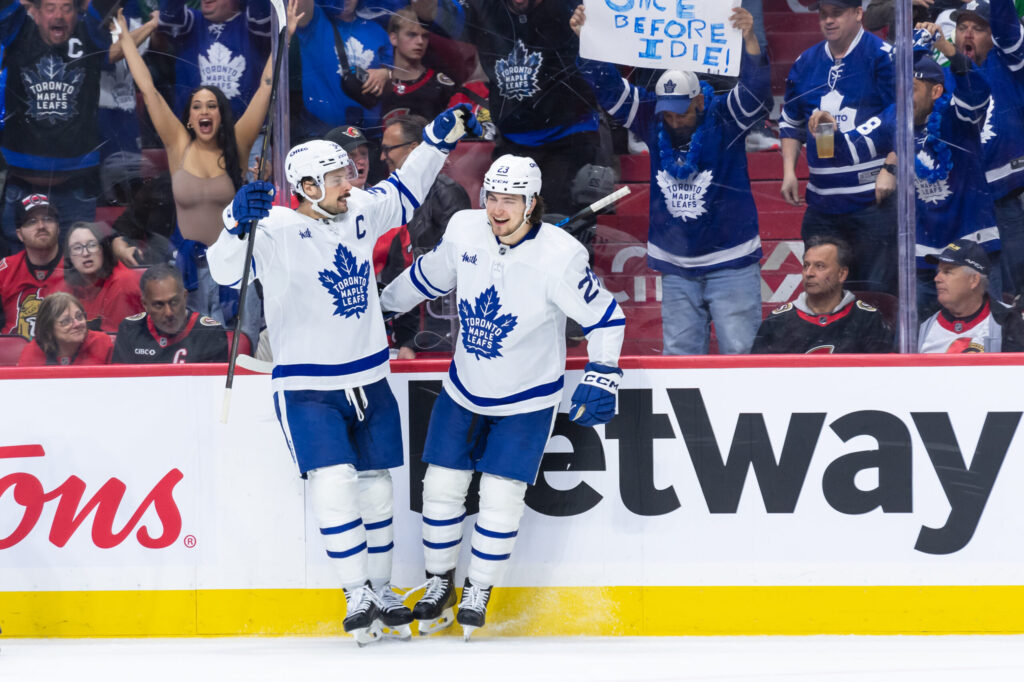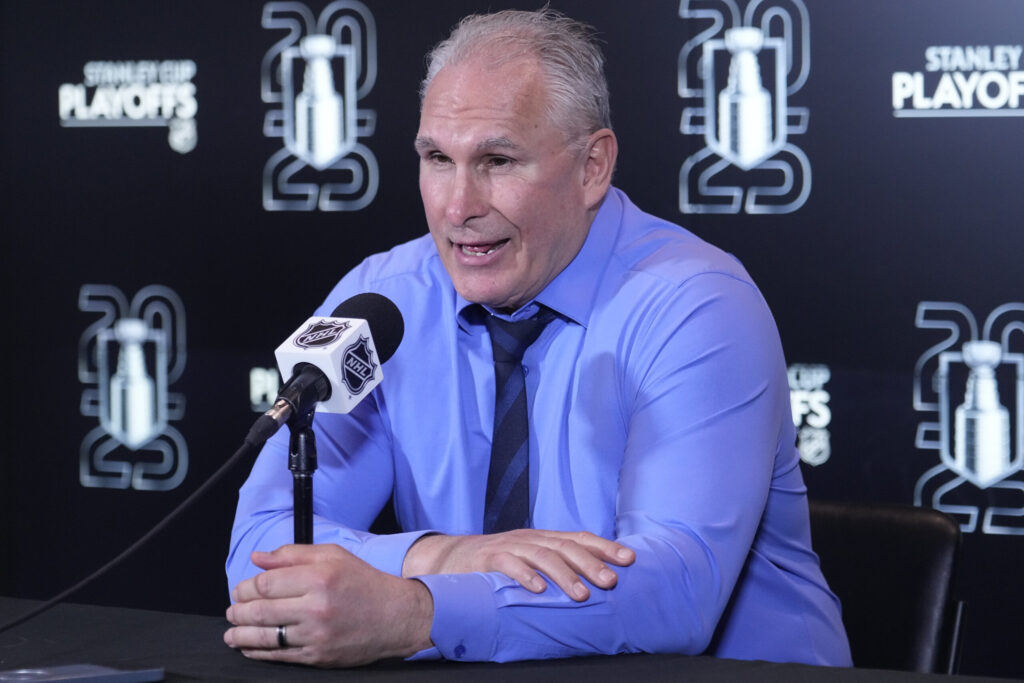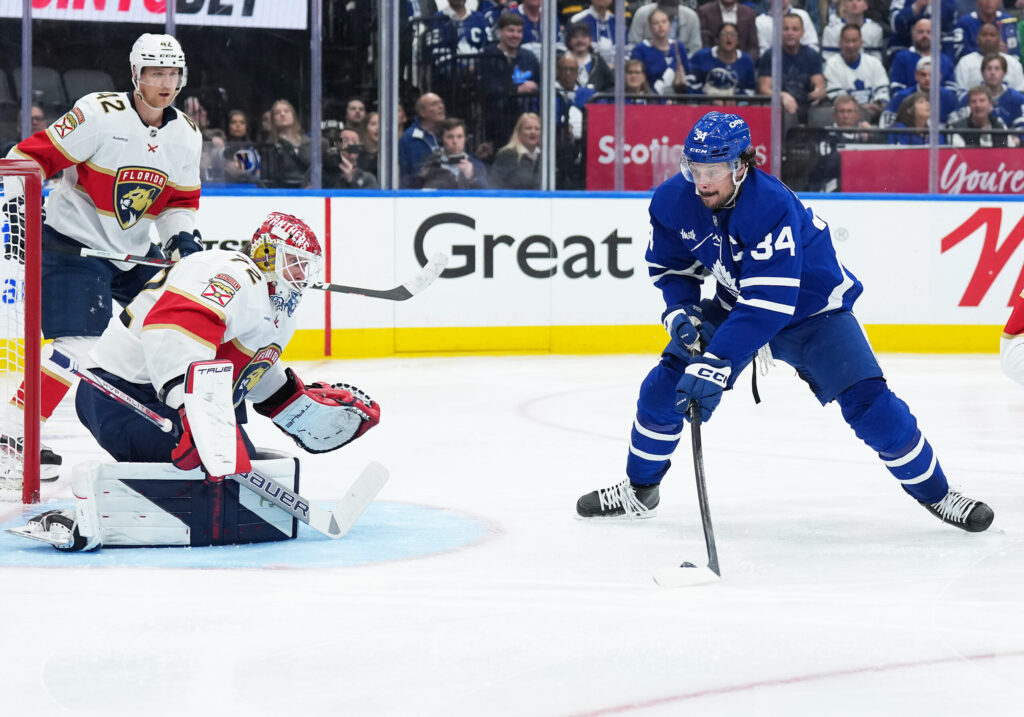The air at the Ford Performance Centre feels different this September. It’s not just the familiar chill of the ice or the echo of pucks off the boards. It’s a change in gravity. For years, the Toronto Maple Leafs’ solar system had two suns, a complex and often turbulent gravitational dance between Auston Matthews and Mitch Marner. Now, one of those stars has been traded to a desert oasis in Vegas, and the other, team president Brendan Shanahan, one of Matthews’ most ardent supporters, is gone. The result is an undeniable truth: the entire Maple Leafs universe now revolves around one man. As Matthews steps onto the ice for the 2025-26 season, he’s not just the team’s best player or its captain. He’s the franchise’s singular focal point, and for the first time, his health, his leadership, and his performance will carry no asterisks and share no spotlight.
Also on the EDGE – The New Equation: 4 Maple Leafs Who Will Define the Post-Marner Era
Battle-Tested and Ready to Fire
Let’s cut to the chase. Last season was a write-off for Matthews by his own stratospheric standards. A nagging upper-body injury cost him 15 games and shackled his on-ice dynamism, culminating in a career-low 33 goals. For a player who potted 69 just a season prior, it was a precipitous drop. Head coach Craig Berube, never one to mince words, even joked about it, noting that in his first year behind the bench, he took Matthews from 69 goals to 33. While said in jest, the underlying point is deadly serious: as Matthews goes, so go the Leafs.

The most encouraging sign for a fanbase desperate for a Hart Trophy-calibre rebound is that the man himself feels the difference. “I’m super happy with how I feel and just how the first two days have gone,” Matthews told reporters. “You never really know until you get back out there… you want to respond and feel really good, and I definitely have.”
Talk is cheap in training camp, but actions on the ice are speaking volumes. During a particularly intense battle drill, defenceman Phil Myers decided to provide a real-world stress test. The 6-foot-5 blueliner didn’t hold back, cross-checking Matthews and muscling him into the boards. It was chippy, aggressive, and exactly what everyone needed to see. Matthews didn’t just endure it; he engaged, battled back, and looked every bit the dominant physical force he is at his best. This wasn’t a player protecting an injury; it was a player who had forgotten he ever had one.
The change is palpable to those who see him every day. “He’s more engaged,” Berube observed. “I think he’s feeling good… He’s harder, heavier on pucks.” His young winger Matthew Knies echoed the sentiment. “He looks really prepared and looks incredible out there. I’m glad he’s 100 percent healthy.” Perhaps most critically, the lethal wrist shot, the one that terrorizes goaltenders league-wide, appears to be back near 100 percent. For a player whose history shows a distinct pattern of bouncing back with a vengeance after a down year, the early signs suggest a storm is brewing.
Forging New Alliances in a Post-Marner World
The departure of Marner isn’t just a personnel change; it’s a seismic shift in the team’s identity and on-ice chemistry. For eight seasons, #16 was the ying to #34’s yang. Now, Matthews must find a new rhythm with a completely retooled top line. The initial configuration sees him flanked by the powerful Matthew Knies on the left and the crafty playmaker Matias Maccelli on the right. Max Domi was the presumed frontrunner for that right-wing spot, but a lower-body injury has him on the shelf to start camp, opening the door for Maccelli.
Building the kind of telepathic chemistry Matthews shared with Marner is a monumental task, and it won’t happen overnight. It requires a conscious effort, something the captain is already focused on. According to Matthews, the key is “getting feedback on different situations that you’re kind of feeling out there.” It’s a process of constant dialogue, of learning tendencies, timing, and sweet spots on the fly. Knies has the size and forechecking ability to create space, while Maccelli brings high-end vision and passing. The potential is there for a dynamic, multi-faceted line, but the burden of integrating them falls squarely on the man in the middle.

If this initial trio fails to find its footing, the coaching staff isn’t without options. A healthy Calle Jarnkrok, the versatile Swiss Army knife of the forward corps, could easily slot in on the right side to provide a more defensively responsible, veteran presence. But the primary goal remains finding a combination that doesn’t just replace Marner’s production but creates a new, perhaps more direct and less predictable, offensive threat.
The Undisputed Weight of the ‘C’
This is Matthews’ second season wearing the ‘C’ on his jersey, but it’s the first where he truly owns it, lock, stock, and barrel. With Marner gone, there is no longer a co-pilot or a secondary leadership voice of equal stature in the room. The hierarchy is clear. As one source noted, “Matthews becomes the face of the team in a way he wasn’t before.”
The pressure cooker is on high. Beyond his Leafs duties, Matthews has been tabbed to captain Team USA at the upcoming Winter Olympics, a testament to his standing among his peers across the league. All this added responsibility seems to have had a grounding effect. Those around the team suggest he sounds more “measured” and “focused.” The chatter about individual hardware and scoring titles has been replaced by a vocabulary centred on leadership and accountability.
His teammates are seeing it firsthand. “He comes into each season with the same mentality that he wants to be the best player, and he wants to lead us,” Knies affirmed. This isn’t the young, record-breaking goal scorer anymore. This is a 28-year-old superstar entering his prime, fully aware that his personal legacy is now inextricably tied to the success—or failure—of his team.
Berube’s Gambit: Unleashing the Beast
Craig Berube isn’t waiting around to see if a healthy Matthews can rediscover his scoring touch; he’s actively engineering the team to make it happen. The key piece in this strategic puzzle is the off-season acquisition of defensive centre Nicolas Roy. Roy’s presence provides the Leafs with a bona fide shutdown presence in the bottom six, which in turn allows Berube to alter Matthews’ deployment.

The plan is to lessen some of Matthews’ more arduous defensive-zone responsibilities. For years, he has been lauded for developing into one of the league’s premier two-way centres, a Selke Trophy finalist who could go head-to-head with any opposing star. While Leafs management still considers him one of the better defensive forwards in hockey, the thinking is clear: Why have your thoroughbred racehorse pulling a plow? By letting Roy handle some of the heavy lifting against top lines and take key defensive-zone draws, Berube can free up Matthews for more offensive-zone starts and transition opportunities. It’s a calculated gambit designed to put the team’s most dangerous weapon in a position to fire as often as possible.
Also on the EDGE – Maple Leafs Nation, Get Ready: Your Future is Calling From the 2025 Prospect Showdown
This season represents a clean slate for Matthews. He’s healthy. He’s the unequivocal leader. He has a coach willing to tailor a system to maximize his offensive gifts. The excuses and the shared responsibilities of the past have vanished. What remains is a singular talent facing a singular mandate: to lead this team where it has never been before. This is no longer the Shanahan-Marner-Matthews era. This is the Auston Matthews era, in its purest form. And for the Maple Leafs, everything depends on it.
Created with the aid of Gemini AI
